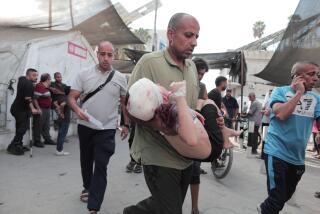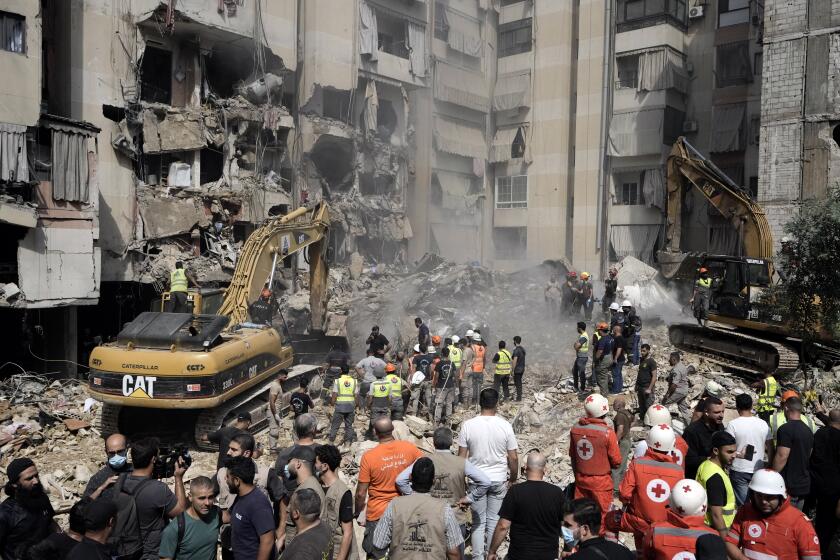Iraqis take tentative security lead
The U.S. and Iraqi infantry soldiers walked in a staggered formation Thursday through northwestern Baghdad’s Ghazaliya district, with its chocolate-colored villas and orange trees.
With the new year, Iraq was now in charge of its own security, including places like this -- a mixed Sunni-Shiite neighborhood that had been the site of raging gun battles during the country’s sectarian war, which lasted for most of 2006 and 2007.
On the first day of the new era, the Iraqi soldiers were still following U.S. soldiers’ instructions on what route to take and whom to talk to. The Americans motioned when to ask residents for information about recent Sunni militant attacks or to tell residents that Iraqi forces, not the Americans, were now in charge here.
The early-morning patrol underscored the delicate nature of what everyone calls a transition, where the American officers refer to their job as partnering with Iraqi combat units, now that a U.S.-Iraq security pact has gone into effect. Under the agreement, which replaced the U.N. mandate that made U.S. forces responsible for Iraq’s security, the Americans must now ask the Iraqis permission for any operation. The pact calls for U.S. forces to leave cities by the end of June and to withdraw from the country by the end of 2011.
Both Iraqi and American soldiers on patrol said that the leadership of raids now varies from mission to mission. Sometimes the Americans lead, other times the Iraqis.
“With this relationship you have one battalion commander . . . in the lead,” said U.S. Army Lt. Col. John Richardson of the 5th Squadron, 4th Cavalry Regiment.
Here in this district, once an elegant spot with mansions and gardens before recent fighting left buildings scarred with bullets, people seemed unaware that the Iraqis were now in charge -- or skeptical that the Americans were relinquishing control, even as they hoisted Iraqi flags on bases throughout the district Thursday.
Allawi Jassem ventured out to buy gas canisters and talked to the Americans, but had no idea that Iraq had taken charge of security. Asked about the day’s significance, he guessed: “Is it Christmas?”
A vegetable seller watching the Americans and Iraqis pass said he had no idea that the Iraqis were really in charge and guessed the U.S. soldiers would still do whatever they wanted.
U.S. officials say they need their own combat formations out with the Iraqis in order to help mentor them in all aspects of soldiering. They think such “partner units” will be necessary even after June 30, when the security accord calls for all U.S. forces to leave Iraq’s cities.
Whether some U.S. troops will be able to stay needs to be negotiated with a Shiite-led government, whose top officials favored sending U.S. forces to bases outside of Baghdad two years ago.
The U.S. conception of training goes beyond providing small teams of advisors and officers that can provide air support, logistics or communications.
The Americans have in mind sizable infantry units prepared for combat missions.
“Those partner formations are for the most part battalions, platoons and companies,” said Brig. Gen. Robin Swan, the deputy commander in Baghdad.
“Partnering extends for every aspect of mission, planning, preparation and execution . . . from the soldier level to a squad leader level to a platoon leader level,” Swan said. “Advisor teams don’t go down that way.”
Here in Ghazaliya, the robust U.S. military presence gives backbone to an Iraqi battalion, which until April struggled with intimidation and interference from local Shiite militias.
An Iraqi soldier named Hossam marched down the street in his secondhand yellow-and-brown camouflage uniform, his weapons vest bearing a patch of an elongated skull labeled “special forces,” and his AK-47 assault rifle sprayed a matching yellow.
He wanted to believe the Iraqis could handle Ghazaliya on their own.
But like his superiors, he admitted his unit still needed U.S. support.
He listed examples of how he still relied on the Americans. Only two days earlier, his Humvee had a flat tire in the road, and his unit waited two hours to get a spare from the Americans because the Iraqi army couldn’t provide it.
“The Americans tell us the Iraqi army doesn’t help itself,” he said. “There is corruption and very little care for the army.”
Even as U.S. and Iraqi commanders talked about how much the Iraqi army has improved, Hossam remembers fighting in spring against Shiite cleric Muqtada Sadr’s Mahdi Army militia -- how his unit was abandoned in the Sadrist stronghold called Shula, which borders Ghazaliya. Of 15 soldiers, 10 escaped when a U.S. helicopter fired on militiamen, he recalled.
Later, Hossam’s battalion commander for Ghazaliya was removed because of desertions during the fighting and the disappearance of military vehicles thought to have been taken by the Mahdi Army, according to a senior U.S. officer.
Hossam feels the Mahdi Army isn’t what it was before, but he is sure it still has spies in his battalion. He wonders how well the army will do if it faces a challenge.
“We’ve improved now, but there haven’t been any major battles,” he said.
“So you can’t predict what will happen next.”
--
More to Read
Sign up for Essential California
The most important California stories and recommendations in your inbox every morning.
You may occasionally receive promotional content from the Los Angeles Times.










